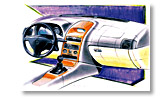
“The challenge consisted in finding a new combination of elements that would be exciting and, at the same time, push ahead with the concept of efficient interior architecture and offer excellent aerodynamics,” explains George 
The previous generation Astra, fortunate successor to the Kadett, contributed more than a little to Opel’s European market success, becoming the all-time best-selling model for the German company. The new car, however, had to face up to an automotive scenario that was evolving rapidly in several areas: design originality, technological content, quality and degree of finish, variety of choice.
Consequently, project T3000 started out from a specially prepared floorpan, proposing new dimensions and proportions and improvements in structural rigidity and robustness. Among the other things, the exterior style had the role of rendering the new qualities of the car perceptible, communicating the precision typical of German engineering as well as the appeal of a decidedly European product.
The initial research phase involved the entire 220-strong team at the Opel Technical Center. Direction of the project was later assigned to design chief Hans-Hermann Wirth. Of the twenty-eight 1:3 scale clay models produced during the prolific early creative phase, eight were selected for in-house assessment and external customer clinics in order to choose the model to develop.
Almost all aspects of the project made use of the computer. Once the styling theme was defined, a lengthy series of alternatives for the front- and rear-end detailing was visualised on-screen, developing later into fully detailed virtual models. When did the project start?
For designers, people whose working lives are projected into the future, dates are never immediately forthcoming: “The definitive version of the surfaces usually predates production start-up by three years, while the majority of the design work is done the year before that,” says Gallion. “As we have a dedicated team for each range of cars, we try to start our projects as soon as possible. Basically, no sooner has a new model been presented than the initial explorations for its successor begin.”
The article continues in Auto & Design no. 109










